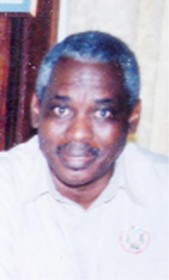-Corlette says no need for any change
The Region Four Regional Democratic Council (RDC) has made no effort to correct or rebuild the flimsy $1.1M Bobby White Street, Bee Hive North Bridge which was constructed last December.

RDC Chairman Clement Corlette on Friday told this newspaper that last week when he discussed the matter with Regional Executive Officer (REO) Shafdar Alli there had been no change with regard to the bridge issue. Despite the available evidence showing that the Bee Hive Bridge was not built to specifications Corlette insisted that this was not the case and that there was no need to change or correct the bridge.
There were two contracts related to the bridge, Corlette said on Friday. The first contract, according to him, was for an amount just over $1.3M. During the construction of the bridge, he explained, the contract was amended to just over $1.1M. Questioned about the $200,000 reduction in the contract, Corlette stated that it was noticed that the beams used by the contractor were short 2 feet of the specified length so the contract was amended to facilitate the lower cost of the shorter beams.
The “roughly constructed” bridge was built in less than a day and a subsequent inspection revealed that the project’s contract had most likely been breached by the contractor, Narindra Lachman. The bridge provides access from the East Coast Public Road to Bee Hive North and is the only way by which vehicles can access the area.
This newspaper viewed a certified copy of the original bill of quantities and contract for the project which was presented to Lachman and signed on October 20 last year. The document indicated that the total cost of the project would be $1, 383, 000 but as explained by Corlette the amount was later reduced.

Lachman and the REO, Alli, signed the project contract and work on the bridge commenced and ended on December 23 last year.
Alli, according to the contract, was effectively the employer. The contract signed by Alli and Lachman clearly states “…failing to complete all or part of this contract, a penalty of $1500 will be levied against the contractor for each day that the Contractor delays to complete works” within 30 days. Stabroek News, despite several efforts made to contact the REO, has been unable to reach him. Alli is yet to indicate whether they will recognize Lachman’s failure to complete the bridge according to specifications as a breach of their agreement and if the penalty will be instituted; what action will be taken against the regional engineer Stephen Glasgow, who was allegedly responsible for oversight of the project, and what will be done about correcting the “flimsy” bridge. Stabroek News has also made numerous attempts to contact Glasgow.
The Haslington/Grove Neighbourhood Democratic Council (NDC) was directly managing the bridge project. As complaints of the bridge’s quality became more frequent the NDC was forced to write to Corlette. A copy of the letter, dated January 13, 2009 seen by this newspaper informed the Regional Chairman of “several defects in the construction of this bridge”.
According to the letter, old and rotten decking planks were used by the contractor to build the revetment; nails instead of six inch spikes were used on the decking and the approaches on both sides of the bridge were filled with mud. Further, the letter which was signed by Deputy Chair of the Haslington/Grove NDC, C. King, said “This bridge was constructed in less than a day…Residents are unanimous in their complaints, and I am therefore requesting an urgent investigation and recommend that no payments should be made until this matter is investigated.” When asked about the NDC letter Corlette refused to comment and again said that despite the initial fault with the bridge’s approach and the slight shift in position there was nothing wrong with the structure.
Senior Superintendentof Works
Another letter, dated July 13, 2009, was sent to Glasgow by REO Alli, informing him that “It has been discovered and confirmed that the construction of ‘Bobby [White]’ Bridge… was not built to specification.”
“This is a very serious matter and should not be taken lightly”, the REO stressed in his letter. He further instructed the Senior Superintendent of Works to “state in writing who authorized the redesign” of the bridge and for what reason. “As the Officer-in-Charge of the project,” Alli’s letter continued, “you [Glasgow] allowed it to continue and also certified same for payments”.
Glasgow was further asked to state, by July 14, 2009, why disciplinary action should not be taken against him. Stabroek News was unable to ascertain whether Glasgow responded or if disciplinary action was ever taken against him.
Questioned about this Corlette said that it had only been recommended by Minister of Transport and Hydraulics Robeson Benn. He stressed – something the minister had already admitted – that Benn had no authority to take disciplinary action against Glasgow.
Corlette used the following analogy as an example – after a journalist gives a story to the editor, if there is a mistake in that story then the editor or the company would be liable and not the journalist because the editor would’ve given the go ahead to print – and said that Glasgow was not “responsible” because it was a matter of organizational hierarchy.
At a July 22 press conference at the Transport Ministry Benn said that while his ministry is lending a hand in the “flimsy” Bee Hive North bridge matter it is “the Ministry of Local Government at the Region Four level” that is responsible for the issue.
“This is a local government issue,” Benn had said. However, while the issue “doesn’t concern our ministry”, he said, it is a natural area they can referee because of their engineering expertise. The Transport and Hydraulic ministry, according to him, is always concerned if a project is done unsatisfactorily.
Benn said he received complaints about the Bobby White Street, Bee Hive North Bridge since January. The bridge was not built to specifications and can only support approximately 7 tons; an amount less than its original capacity.
He had called the Ministry of Local Government, Benn said but didn’t get the type of information he thought requisite. Engineers from the Transport and Hydraulics ministry were subsequently dispatched, Benn said, and they later reported faults with the bridge. These reports, Benn said, prompted his July 10 visit to the bridge along with Minister of Local Government Kellawan Lall. It was his “third or fourth” visit to the bridge, he noted adding that the Ministry of Local Government has “people” who award and look after the issue. Efforts made to contact Lall on Friday were futile.
Benn again said that he had advised that the contractor not be paid. According to the minister, Glasgow had reported on July 10 that the bridge was built to specifications but when questioned about the size of screws and length of wood he could not answer.
“I asked [Glasgow] how can you … try to mislead two ministers of government; you should go home pending investigation,” Benn said.
However, he again noted that he does not have the authority to send the man home and can only recommend that it be done. Benn had added that he has since had no feedback about the matter and couldn’t say if Glasgow was disciplined.
Inconvenienced
A visit to the Bee Hive North Bridge on Friday revealed that the structure was indeed “untouched”. Several residents voiced their concerns and said that the project was a waste of state funds because the structure was not durable.
Chatenauth Gyandat, a resident of the area and contractor since 1971, explained that the only way to correct the bridge is to rebuild it. The man explained that the bridge’s revetment, an important element, was not built to specifications and the only way to correct this is to “build the structure from scratch again”.
“A faulty revetment is very dangerous,” Gyandat said. “If it is breached then the street can cave in and possibly cause the bridge to collapse.”
Gyandat along with Robert Wight and several other residents have been vigorously following the “flimsy bridge” issue. The man explained that it is important the structure is strong because it is the only way vehicles can access the area.
Several Bobby White Street residents including him, Gyandat said, have had construction projects stalled. In addition to this, a wood craftsman/joiner depends on the bridge to have his materials delivered to his workshop. However, since the bridge’s weight capacity has been reduced it had limited the amount of material that can be transported into the area at a time.
“We are greatly inconvenienced by this piece of substandard structure,” Gyandat stated, “and its life is limited. By the time we’ve transported 100 or more 7 ton loads over that bridge what do you think will happen to it? It will become very weakened, dangerous and will need rebuilding.”




